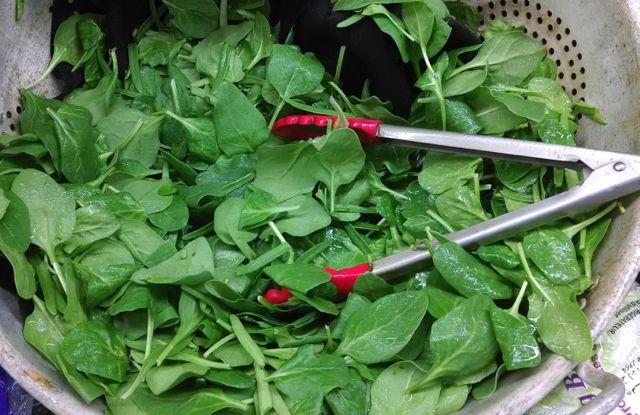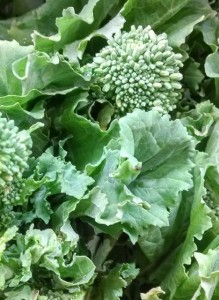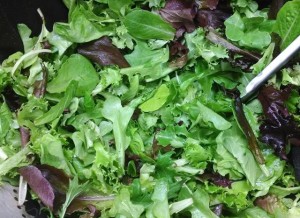
By Mary Ellen Psaltis
 March marks the end of winter and the end of whatever fresh vegetables you had hidden/stored/buried away. Then March teases us with spring. Jan Pigman, of Pigman’s Organic Produce Patch, said the last of her potatoes in the ground had turned to mush. One might uproot a carrot or leek, but the ‘pickins’ are slim. If you could peek inside local green houses, you’d find trays of spinach, mustard green and radishes laid out like solar panels, hoping to absorb every ounce of heat and light that March can deliver.
March marks the end of winter and the end of whatever fresh vegetables you had hidden/stored/buried away. Then March teases us with spring. Jan Pigman, of Pigman’s Organic Produce Patch, said the last of her potatoes in the ground had turned to mush. One might uproot a carrot or leek, but the ‘pickins’ are slim. If you could peek inside local green houses, you’d find trays of spinach, mustard green and radishes laid out like solar panels, hoping to absorb every ounce of heat and light that March can deliver.
Pray for the sun to shine and the temperatures to go up! My taste buds and I are more than ready for tender spring vegetables.
 In truth, you can still round up shallots, dried beans, oyster mushrooms and a few potatoes, but I’m looking forward to fifty shades of green. The future of the first harvest depends mostly on the weather. The Farmer’s Almanac predicts 49 degrees, some cool, some warm, and rainy periods (you already guessed that). Pigman noted that farmers, being optimists, don’t buy lottery tickets but gamble on the weather instead. “Well, you have about a 50-50 chance.” Please think sunshine.
In truth, you can still round up shallots, dried beans, oyster mushrooms and a few potatoes, but I’m looking forward to fifty shades of green. The future of the first harvest depends mostly on the weather. The Farmer’s Almanac predicts 49 degrees, some cool, some warm, and rainy periods (you already guessed that). Pigman noted that farmers, being optimists, don’t buy lottery tickets but gamble on the weather instead. “Well, you have about a 50-50 chance.” Please think sunshine.
Produce will come… eventually. Here’s what to look forward to eating:
The heartiest and first outside plants are spinach and kale. Baby bok choy will also be in the mix. Broccoli and chard will be transplanted along with cauliflower. Kirsop Farm has many plants germinating in green houses, which will later be transplanted to fields. Next come radishes, arugula and a lettuce mix. By the end of April we can hope for full heads of lettuce.
Olympia Local Foods owner, Celia Husmann, expects to have local baby greens mixed salad, spinach and garlic scopes. Of course, the timing is weather dependent. At this time the available kale and chard come from neighboring Oregon or California. Husmann looks forward to the “variety (of produce) from farms and the freshness,” appreciating the connections with those who grew the vegetables. Stop by their food and grocery store to see what’s new.
 Have you heard of microgreens? Trendy yet nutritious, microgreens are the first leaves from plants grown indoors. Pulsating with youth (harvested less than 14 days after germination) they might originate from purple mustard, spinach, basil, pea or cilantro plants. I guess you need a LOT to make a salad, but you can sprinkle a few on your sandwich, in your soup or on your sauce for a splash of vibrancy. Once these seedlings of edible herbs and vegetables were found only in restaurants, but now microgreens have made their way into general circulation. Tests are still be run to determine if these baby greens are more nutritious than their ‘adult’ counterparts, but it really doesn’t matter. They are all good for you!
Have you heard of microgreens? Trendy yet nutritious, microgreens are the first leaves from plants grown indoors. Pulsating with youth (harvested less than 14 days after germination) they might originate from purple mustard, spinach, basil, pea or cilantro plants. I guess you need a LOT to make a salad, but you can sprinkle a few on your sandwich, in your soup or on your sauce for a splash of vibrancy. Once these seedlings of edible herbs and vegetables were found only in restaurants, but now microgreens have made their way into general circulation. Tests are still be run to determine if these baby greens are more nutritious than their ‘adult’ counterparts, but it really doesn’t matter. They are all good for you!
I only recently learned from Jan Pigman about yacons, a tuberous vegetable with fruity characteristics. Part of the dahlia family, they can be eaten raw and are reminiscent of an Asian pear. People who planted them are enjoying them. Sounds good – but I am still thinking warm sunshine and sprouting leaves. Here’s to bowls-full of local greens!
Eat Well – Be Well
















































